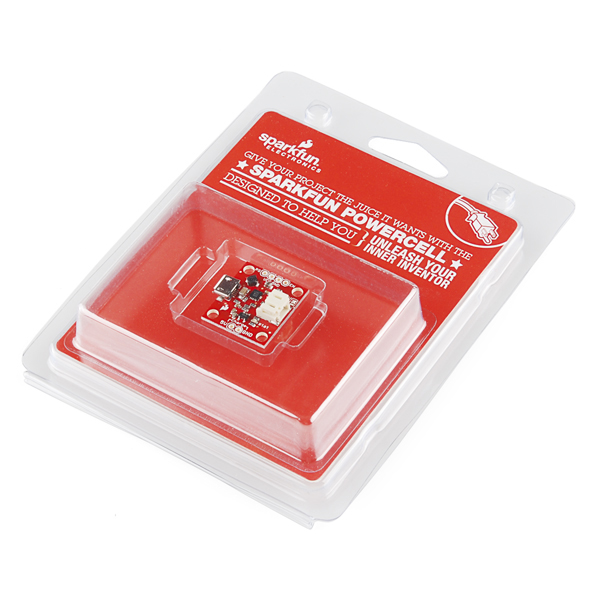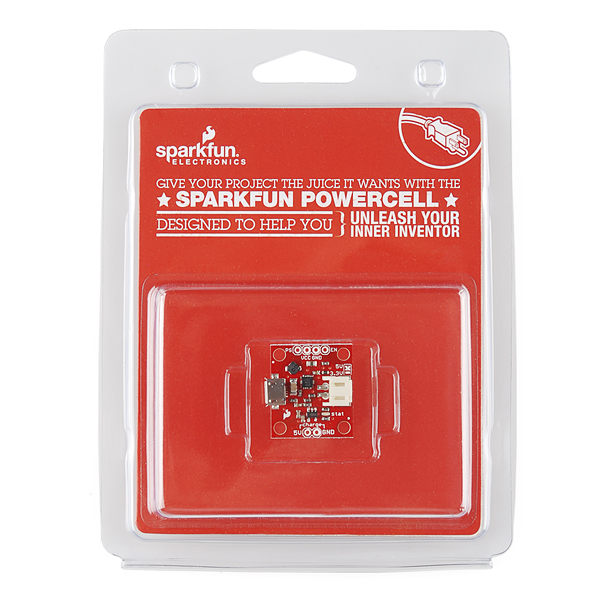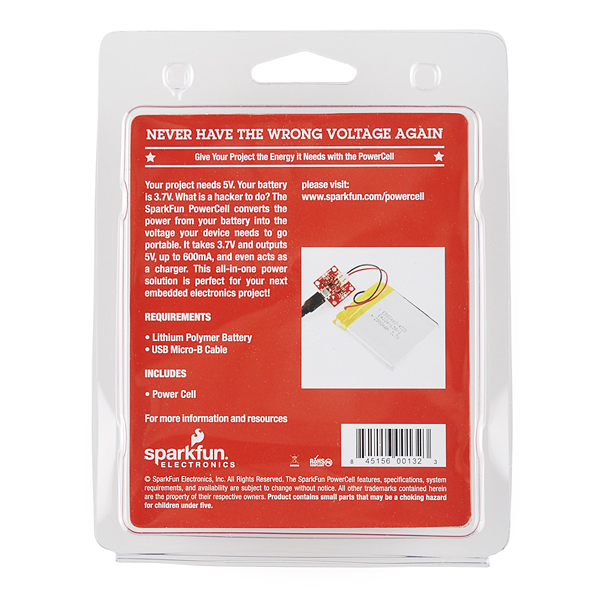PowerCell Retail
This is the same product as the Power Cell - Lipo Charger/Booster. The difference is this version comes in fancy clamshell packaging meant for our distributors that need it. Regular customers are welcome to order, but we want to limit the amount of extra packaging finding its way into the trash heap.
The PowerCell board is a single cell LiPo boost converter (to 3.3V and 5V) and micro-USB charger in one. The board comes with a JST connector for a single cell LiPo battery, a micro-USB connector for the 5V charge input, and selectable 3.3V and 5V ouput pins (labeled 'out'). There are also two charge pins broken out (labeled 'charge'), so you can use another 5V power source to charge the batteries, if you don't have a micro-USB cable.
We've also broken out the power-save and enable pins, so that you can have full control of the switching regulator. Keep in mind, if you keep your battery connected to the Powercell, it is recommended that you disable the switching regulator (pull EN low) in order to prevent the battery from discharging and reaching the under voltage cutoff on the battery itself. There is also an under-voltage lockout on the Powercell board which is tied to a solder jumper so that you can disable it if you like.
The micro-USB charger uses the MCP73831 and allows you to charge 3.7V LiPo cells at a rate of 100mA max. If you want to charge at a faster rate, you will need to connect a separate power supply to the pins labeled '5V' and 'GND' under the label 'charge'.
The boost converter is based on the TPS61200 from TI and has solder jumper selectable 5V and 3.3V output, and an under voltage protection of 2.6V (which can be disabled via solder jumper on the back of the PCB).
Note: This board does not have reverse polarity protection, so please be sure to recognize the polarity of your connections!
- MCP73831 Single Cell LiPo charger at 500mA
- TPS61200 Boost Converter
- Selectable output voltage 3.3 or 5V
- 5V @ 600mA max
- 3.3V @ 200mA max
- Undervoltage lock out at 2.6V (with disable jumper)
- Quiescent current, less than 55uA
- JST connector for LiPo battery
- micro-USB connector for charge power source
- Inductor: 4.7uH, 1.2A Sumida CDRH2D18
- Over temperature protection
- Schematic
- Eagle Files
- Tutorial
- Datasheet (MCP73831T)
- Datasheet (TPS61200)
PowerCell Retail Product Help and Resources
Core Skill: Soldering
This skill defines how difficult the soldering is on a particular product. It might be a couple simple solder joints, or require special reflow tools.
Skill Level: Noob - Some basic soldering is required, but it is limited to a just a few pins, basic through-hole soldering, and couple (if any) polarized components. A basic soldering iron is all you should need.
See all skill levels
Core Skill: Electrical Prototyping
If it requires power, you need to know how much, what all the pins do, and how to hook it up. You may need to reference datasheets, schematics, and know the ins and outs of electronics.
Skill Level: Rookie - You may be required to know a bit more about the component, such as orientation, or how to hook it up, in addition to power requirements. You will need to understand polarized components.
See all skill levels
Comments
Looking for answers to technical questions?
We welcome your comments and suggestions below. However, if you are looking for solutions to technical questions please see our Technical Assistance page.
Customer Reviews
No reviews yet.




I purchased three of these for use with XBees, and moved the solder jumper to 3.3v. Of the three, one entirely failed to work, and another output 4V, destroying an XBee. Purchase this product at your own risk.
Please contact techsupport at sparkfun dot com. You either have defective boards or you are using the boards incorrectly. Tutorial on how to use this board can be found here.
Is it just me or is the link on the back broken.
Sorry about that, these got out faster than we were able to get the page ready. It should be up very soon.
Wow, a $5.00 USD for low volume, and $4.00 at high volume, price difference between this and the non-retail packaged version. I guess you guys are serious about limiting the amount of waste that ends up in landfills.